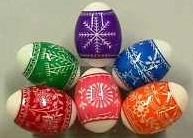 About an hour down the highway from our farm is the world's allegedly largest pysanka, or Ukrainian Easter egg. And because I married my half-Croatian self into a large Ukrainian family, it seemed fate last year when, just before Easter, at the drugstore right next to the display of wax and styluses and dyes, I found a neat little invention, "Egg-in-Wrap: Beautiful Ukrainian Easter Eggs without the Work", manufactured by the wonderful folks at Leemar Enterprises of Wayne, New Jersey.
About an hour down the highway from our farm is the world's allegedly largest pysanka, or Ukrainian Easter egg. And because I married my half-Croatian self into a large Ukrainian family, it seemed fate last year when, just before Easter, at the drugstore right next to the display of wax and styluses and dyes, I found a neat little invention, "Egg-in-Wrap: Beautiful Ukrainian Easter Eggs without the Work", manufactured by the wonderful folks at Leemar Enterprises of Wayne, New Jersey. The envelope, which looks very much like a seed package, contains 12 plastic sleeves imprinted with traditional designs; you slip a sleeve over an egg (hardboiled, raw, blown, ceramic, or plastic -- the kids decided that they liked to dye our hardboiled eggs a solid color first), place the egg on a spoon and then dip in boiling water until the plastic sleeve shrinks around the egg. Ta da! They turn out so prettily it's almost a shame to crack and eat them after a couple of days.
The envelope, which looks very much like a seed package, contains 12 plastic sleeves imprinted with traditional designs; you slip a sleeve over an egg (hardboiled, raw, blown, ceramic, or plastic -- the kids decided that they liked to dye our hardboiled eggs a solid color first), place the egg on a spoon and then dip in boiling water until the plastic sleeve shrinks around the egg. Ta da! They turn out so prettily it's almost a shame to crack and eat them after a couple of days.If you want to try the authentic non-plastic wrap Ukrainian method, Leemar has everything you need, from A Kid's Guide to the full-blown adult stuff. And if you're looking for another way to decorate eggs, Billi-Jean at My Bountiful Life... has advice on how to make natural dyes with vegetables, fruits, and spices.
Speaking of Ukrainian Easter, this is the time of year that we, the anti-Atkins family, eat close to our weight in paska, a round, rich, eggy loaf, very similar to the Russian Easter kulich. It's traditionally elaborately decorated with dough ornaments when the loaf is taken to church to be blessed by the priest, but our loaves tend to have a very short life and don't make it too far from the kitchen. You can use regular bread pans, but it's traditional in this part of Alberta to use large coffee cans, either the two-pound or two-kilogram variety. Here's my husband's late grandmother's recipe, which makes several loaves:
Paska (Ukrainian Easter bread)
1 cup water, lukewarm
1 tsp. sugar
1 tbsp. active dry yeast
3 cups scalded milk, lukewarm
5 cups flour (it's supposed to be sifted but I don't have a sifter; what I do is use a spoon to pour flour into my measuring cup -- don't use your measuring cup as a scoop because it compacts the flour and you end up with way too much) and then use a knife to remove the excess
6 eggs, room temperature, beaten
1/2 cup unsalted butter, melted
1 cup sugar
1 tsp. salt
9 - 10 cups flour
1 cup raisins (the kids like the golden ones in this recipe)
Preheat oven to 350 F. Place the water in a measuring cup and add sugar and yeast. Stir a little to dissolve and let stand for 10 minutes to get all bubbly.
Combine the yeast mixture with the lukewarm milk and the 5 cups flour. Cover and let the batter rise in a warm place, covered by a tea towel, about an hour. Add the eggs, sugar, melted butter, and salt; mix thoroughly. Add raisins. Stir in flour one cup at a time to make a dough that isn't too stiff or too soft, and keep kneading until the dough is smooth and glossy and doesn't stick to your hands. Place in a bowl, cover, and let it rise in a warm place until double in bulk. Punch down and let it rise again.
If you plan to decorate the loaves with dough cutouts, separate the dough into three equal parts and reserve one of them for making braids and leaves. Otherwise, divide the dough in two sections. Prepare either two or three 2kg coffee cans, with melted butter and some flour (shake out excess). Shape the loaves into rounds (if using coffee cans) and place each in a prepared pan;the dough should be about 1/3 from the top of the can. If you're making dough cutouts, you can make a traditional cross for the center, and surrounded it with leaves, flowers, petals, and/or braids.
Set the loaves in a warm place until they are almost double in bulk. Brush with one beaten egg with 2 tbsp. water. Bake at 350F for about 40 minutes; the top should be golden rather than brown (you may neeed to cover with aluminum foil). Let loaves cool in the pan for about 10 minutes, then remove from pans and cool more.
Leftovers are very nice toasted or turned into French (um, Ukrainian) toast.
No comments:
Post a Comment